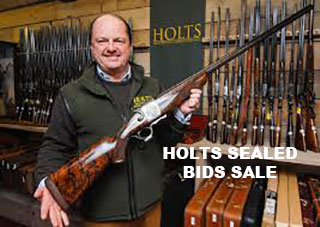April was dominated by Gavin Gardiner’s sale, which was a fair bit bigger than he expected thanks to a few probate-delayed collections getting the go-ahead in time for catalogue inclusion.
Chatting to Gavin before I went to visit him in West Sussex, he reflected on the way the market for pairs of 12-bores has gone rather soft. Once the object of desire for many an up-and-coming young man, perhaps based on his childhood memories of someone revered who owned a pair of Purdeys, or perhaps motivated by family stories of a pair once owned and sold off in the dark, post-war days of austerity.
Whatever the catalyst, it was common for a chap to buy a pair once he had made a bit of money and was able to indulge himself. There used to be a bit of a check list of items that were necessary to line up and tick-off as time passed. A BMW, a Rolex, a flat, a pair of Purdeys. It no longer seems to be the case.
Many a London-based professional no longer sees the justification for keeping a car in the city, the heirloom Rolex has, for many a millennial, given way to a smart watch that will probably have a life expectancy of two years, and the pair of side-locks (Purdeys if you can afford them) are no longer on the radar.

Today’s thirty something probably learned to shoot with an over & under, as did his father. If he aspires to anything, it is probably a ‘posh’ version of his Silver Pigeon. Not great news for someone like Gavin, who makes a living selling old guns to new buyers. However, all is not lost.
The market is remarkably lively in some unexpected areas. Collectible pistols, Section 58 rifles, anything unusual in good condition, especially hammer guns; all are solid areas for sales and good prices are being achieved. As a dealer, I acknowledged to Gavin that some of the prices he realised in recent auction sales are beyond what I could expect to achieve on a retail basis.
This being the case, I was intrigued to see a very nice range of vintage rifles in the April sale. All were within the reach of a moderately comfortably-off collector, rather than being the preserve of oil barons and some very good examples were included among them.
Anyone wanting a representative sample of the classic magazine sporting rifles available between 1900 and 1939 needs one of each of the following: A Lee Speed .303, a Mannlicher-Schonauer 6.5x54, a .256 Mannlicher and a .275 Rigby Mauser. Gavin had examples of all these - good ones too.
Enthusiasts have to resort to home loading if they want to use these classics.
The most expensive purchase would be the £2,000- £3,000 estimated Rigby. The others all carried estimates of £500-£700. It is perhaps interesting to observe that the prices for these models were very close when they were new (all between eight and ten pounds according to a 1912 catalogue I have) so the inflated price in today’s market of the Rigby makes the others look good value by comparison.
The Rigby .275 is the most efficient and widely applicable of these cartridges, as well as being the most readily obtainable. The support offered by Rigby as a successful modern company also adds to the practical and emotional attraction of owning one.

The .256 Mannlicher, the .303 British and the 6.5x54 are all getting hard to obtain ammunition for in quality sporting loads from commercial manufacturers. I don’t think anyone is currently loading them. Enthusiasts have to resort to home loading if they want to use these classics in the field. That especially applies to anyone wanting to hunt Scottish deer with a 6.5, as most commercial loads didn’t quite hit the right levels to meet legislative requirements.
As is often the case, auctions offer one avenue to explore for old stocks of obsolete ammunition, when the usual commercial sources have dried up. While a lot of the very ancient Kynoch ammo is probably long past being considered a reliable hunting choice, it does offer re-loadable brass. RWS manufactured the 6.5x54 until quite recently so remnant stocks of that are the ones to keep looking out for.
Southams in Bedford have regular on-line ammunition auctions and a search facility makes finding out what might be available, in the cartridge you need, easy and quick.
British boxlocks remain great value. If you are fortunate enough to have a son reaching his majority and who is happy to shoot a side-by-side, you can buy him a very crisp English boxlock for about what it would have cost (in pure pounds and pence terms) thirty years ago. They may not be ‘investments but they are very good practical purchases. Prices are so low that it is hard to see them dropping any further.
As we head into May, we have a sale in London to anticipate. Bonham’s are now the only big auctioneers of firearms remaining in London. The sale on May 27th can be viewed in Montpellier Street and I intend to head into town for the first time in a couple of years to take look.

The sale features 218 lots, starting with accessories and revolvers, through collectible pistols and small bore rifles to double rifles, hammer guns and modern over & under guns. Interestingly, there is a new Rigby .416, which is number one of a limited run of ten rifles built during lockdown, with a reserve of £6,000. For the double rifle enthusiast, a Holland & Holland .450 Express made in 1905 as a best non-ejector side-lock looks good value at its £10,000 reserve, which is what a plain Jeffery boxlock make in the last Holt’s sale.
There are several sub-£1,000 boxlocks, including the reliable old Webley & Scott Model 700, which is such a bargain right now it seems silly not to buy one and a back-up gun, especially the 2 3/4” chambered version. With that you could shoot standard steel without any guilt or worry. A pair of 16-bore Model 700s with a reserve of £1,200 look a very sound buy.

Towards the end of the sale, there are some very nice examples of Boss, Purdey and Holland & Holland best side-locks and a good number of pairs, including Damascus barrelled side-lever Boss 12-bores and a pair of vintage Rigby side-locks made in 1906.
As always, keep an eye out for provincial bargains via The Saleroom on your computer. It can be a good source of the unusual (I bought a Mannlicher-Schonauer 6.5 with a broken stock for £190 as a donor action for a custom rifle project at Mitchell’s last week) and old stocks of ammunition.
I’m looking forward to my long-overdue trip to London; maybe I’ll see you at Bonhams?
Published by Vintage Guns Ltd on




